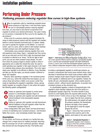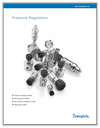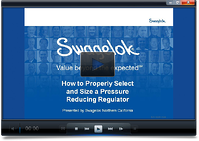Share this
"Sizing Pressure Regulators" Q&A Recap; Slide Deck Now Available
by Jeff Hopkins on 1/23/13 8:00 AM
This post has 5 answers to technical questions about pressure regulators and a link to download slides from last week's technical briefing
Last week Swagelok field engineer Eric Kayla was at our Fremont office to lead a briefing on match the right regulator to a particular job. If you didn't come to the technical briefing last Thursday, you can still benefit in a couple of ways.
One is to download the slide deck that Eric used during the webinar. It's available for free on our website. The slide deck includes tips on interpreting flow curves, the graphs that illustrate how a regulator will perform with different combinations of flow and pressure.
The other is to check out these answers to the questions Kayla fielded after the presentation:
Q: Can you interpolate below the lowest published flow curve?
A: When interpolating flow curves it’s easier when you have a higher boundary and a lower boundary. However, when you’re interpolating below the flow curve you don’t have that floor or that sense of what’s low enough. Interpolating below the line is more difficult and less scientific.
Q: What happens if you operate a regulator outside its optimal flow range?
A: If you’re on the low side of the flow range you’ll be operating in the area of seat load drop -- also called lock-up -- and you’ll get an erratic reading. If you operate to the high side of the flow range, you’ll begin to operate toward the choke flow point. At that point, the poppet is fully out of the seat, and it’s literally operating as a restricting orifice, and you’re not able to adjust the regulator much.
Q: How can you minimize droop?
A: Droop is characteristic of the regulator based on its mechanical operation. Different loading mechanisms can improve the droop. So if the droop of your spring-loaded regulator is too severe, you could change to a dome-loaded regulator and that will push the curve flow towards horizontal, reducing the droop.
Q: What if some of our regulators were sized using Cv method?
A: Cv is calculated at the choke flow point. So if you were to operate on far right of the flow curve, with the poppet pushed as far as it can go, it’ll be more like a restricting orifice and less like a regulator.
Q: Why would someone use a left-to-right flow curve over a right-to-left flow?
A: The flow path depends on the installation point of the regulator. That is, where does the high pressure come in, where does the low pressure need to be delivered, and where is the regulator physically installed in the system?
Additional resources
 |
 |
 |
| Technical Bulletin and Article on Pressure Regulator Flow Curves | Slide Deck: Theory & Operation of Pressure Reducing Regulators | Swagelok Pressure Regulators Catalog |
Related articles
Share this
- Archive (465)
- Assembly Services (207)
- About (100)
- Seal Support Systems (96)
- Best Practices (88)
- Training Services (74)
- Fittings (51)
- Semiconductor Applications (49)
- Hoses and Flexible Tubing (47)
- Regulators (44)
- Tubing (42)
- Grab Sampling Systems (32)
- Sampling Systems (32)
- Gas Systems (30)
- Services (30)
- Downloads (29)
- Valves (24)
- Application Support (18)
- Orbital Welding (17)
- Case Studies (13)
- Steam Systems (13)
- Frequently Asked Questions (12)
- Tools (12)
- Measurement Devices (7)
- Subsystems (6)
- Thermal Management (6)
- September 2023 (1)
- August 2023 (2)
- June 2023 (1)
- March 2023 (3)
- February 2023 (3)
- January 2023 (4)
- December 2022 (4)
- November 2022 (4)
- October 2022 (4)
- September 2022 (1)
- August 2022 (3)
- July 2022 (2)
- June 2022 (4)
- May 2022 (1)
- April 2022 (2)
- March 2022 (1)
- February 2022 (2)
- January 2022 (3)
- December 2021 (1)
- November 2021 (6)
- October 2021 (6)
- September 2021 (8)
- August 2021 (4)
- July 2021 (3)
- June 2021 (6)
- May 2021 (6)
- April 2021 (7)
- March 2021 (5)
- February 2021 (4)
- January 2021 (6)
- December 2020 (5)
- November 2020 (6)
- October 2020 (6)
- September 2020 (8)
- August 2020 (7)
- July 2020 (8)
- June 2020 (8)
- May 2020 (6)
- April 2020 (9)
- March 2020 (7)
- February 2020 (10)
- January 2020 (21)
- December 2019 (23)
- November 2019 (21)
- October 2019 (22)
- September 2019 (21)
- August 2019 (22)
- July 2019 (23)
- June 2019 (20)
- May 2019 (23)
- April 2019 (22)
- March 2019 (21)
- February 2019 (20)
- January 2019 (21)
- December 2018 (14)
- November 2018 (19)
- October 2018 (23)
- September 2018 (17)
- August 2018 (29)
- July 2018 (11)
- June 2018 (6)
- May 2018 (5)
- April 2018 (4)
- March 2018 (5)
- February 2018 (3)
- January 2018 (3)
- December 2017 (2)
- November 2017 (4)
- October 2017 (3)
- September 2017 (2)
- August 2017 (6)
- July 2017 (4)
- June 2017 (4)
- May 2017 (4)
- April 2017 (3)
- March 2017 (4)
- February 2017 (3)
- January 2017 (3)
- December 2016 (3)
- November 2016 (3)
- October 2016 (3)
- September 2016 (5)
- August 2016 (5)
- July 2016 (4)
- June 2016 (5)
- May 2016 (3)
- April 2016 (4)
- March 2016 (5)
- February 2016 (11)
- January 2016 (1)
- December 2015 (3)
- November 2015 (4)
- October 2015 (3)
- September 2015 (4)
- August 2015 (4)
- July 2015 (8)
- June 2015 (5)
- May 2015 (3)
- April 2015 (4)
- March 2015 (4)
- February 2015 (3)
- January 2015 (4)
- December 2014 (2)
- November 2014 (3)
- October 2014 (4)
- September 2014 (4)
- August 2014 (4)
- July 2014 (5)
- June 2014 (4)
- May 2014 (4)
- April 2014 (5)
- March 2014 (4)
- February 2014 (3)
- January 2014 (4)
- December 2013 (5)
- November 2013 (3)
- October 2013 (4)
- September 2013 (3)
- August 2013 (5)
- July 2013 (5)
- June 2013 (5)
- May 2013 (3)
- April 2013 (6)
- March 2013 (4)
- February 2013 (4)
- January 2013 (8)
- December 2012 (4)
- November 2012 (6)
- October 2012 (6)
- September 2012 (4)
- August 2012 (4)
- July 2012 (4)
- June 2012 (4)

.webp?width=210&height=70&name=StickyLogo%20(5).webp)
